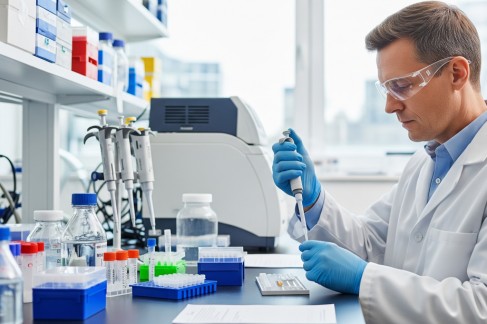
What is PCR? Benefits of Multiplex PCR Over Singleplex PCR: An Overview for Researchers
PCR or Polymerase Chain Reaction is a replication technique used in medical biology research to create multiple copies of a certain DNA segment. This technique was developed by Kary Mullis in 1983.
The PCR technique is based on the enzymatic replication of DNA conducted in vitro. There are several types of PCR techniques, but the one that is most prominently used by researchers is Multiplex PCR.
This technique is an advancement over simplex PCR that allows for the amplification of multiple DNA targets simultaneously within a single reaction. From increased data reliability to cost saving, let’s dissect what makes multiplex PCR potent over singleplex PCR.
What are the Components of PCR?
The primary components of PCR are:
- Template DNA: In PCR, the template DNA – a short segment of DNA - is the target DNA that needs amplification.
- Primers: The template DNA is amplified using primers. Primers are short, single-stranded DNA sequences that act as a starting point for DNA synthesis. Usually, 18-25 nucleotides are used as primers.
- DNA Polymerase: After this, the Taq polymerase is used as a DNA polymerase. It synthesizes new strands of DNA complementary to the template DNA by extending the primers.
- dNTPs: After this, dNTPs (deoxynucleotide triphosphates, such as dATP, dTTP, dGTP, dCTP) are added that act as the building blocks for new DNA.
- Buffer System: The buffer system (magnesium and potassium) provides optimum conditions for DNA denaturation and renaturation.
In a PCR reaction, the components undergo multiple cycles of heating and cooling to produce the required DNA.
What is the Process of PCR?
PCR is conducted in three steps, including:
- Denaturation: Heat the reaction mixture at 96℃ for 0.5-2 minutes. This step separates or denatures the DNA strands. These strands act as template DNA.
- Annealing: Now, cool the reaction to 55-65℃ for 20-40 seconds. This is done so that the primers can bind to their complementary sequences on the single-stranded template DNA.
- Extension: At this step, the temperature is raised again to 72℃. The Taq polymerase is added to extend the primers, synthesizing new DNA strands by adding dNTPs in the 5’ →3’ direction.
Note: After each cycle, the number of DNA copies doubles, leading to exponential amplification. A typical PCR run lasts 25–35 cycles and takes 1–2 hours.
What Makes Multiplex PCR Important for Research?
Unlike singleplex PCR, in which only one DNA target is amplified per reaction, multiplex PCR allows simultaneous amplification of multiple targets in a single reaction tube. This process is done using multiple primer sets. This technique has become very useful for research applications because of:
Increased data throughput
In singleplex PCR, analyzing multiple DNA targets requires multiple individual reactions, each with its own reagents and thermal cycles. On the other hand, multiplex PCR can amplify multiple DNA sequences simultaneously. This reduces the number of reactions required and leads to higher data throughput, that too at a shorter time frame.
Reduced sample volume requirements
The PCR technique is used to amplify a small amount of DNA sample. However, singleplex PRC consumes more amount of sample for each reaction. Since the DNA sample is already limited, multiplex PCR can preserve the sample for further research by amplifying multiple targets from the same DNA sample.
Time and Cost Efficient
Performing multiple singleplex PCR reactions can be labor-intensive, time-consuming and expensive because they require more tubes, reagents and plasticware. However, multiplex PCR requires few reagents and can be completed in a relatively short time frame. Moreover, this requires fewer pipetting and setup steps. As a result, this can help save significant time and cost.
Better internal control
In multiplex PCR, multiple DNA targets are amplified in the same reaction. So, this allows built-in validation of results and improves the reliability and reproducibility of experiments. Since all amplifications in the same tube will appear, researchers can ensure that the absence of amplification for one target isn’t due to a failed reaction.
Improved sensitivity and specificity
Multiplex PCR maintains the same sensitivity and specificity as singleplex PCR, especially when optimized properly. Moreover, carefully designed primers prevent cross-reactivity and primer-dimer formation. Advanced tools can help researchers create compatible primer sets for multiplexing. So, this technique helps researchers to detect multiple rare variants simultaneously, especially in applications where there is a need for the detection of low-abundance genetic mutations.
Quantitative and qualitative analysis
Multiplex PCR is not just limited to detecting the presence or absence of DNA. Instead, it is widely used as a quantitative PCR assay to measure gene expression. Fluorescent labels and probes allow real-time monitoring of multiple amplicons. This provides precise quantification.
The Bottom Line
While PCR has revolutionized molecular biology research, multiplex PCR is a more efficient and cost-effective method as compared to singleplex PCR. For researchers working in genetic screening or cancer research, multiplex PCR is a more potent method.
However, the output of your research experiment depends on the PCR kit you choose. So, make sure you buy your tools for PCR from a reliable source.

Comments (0)